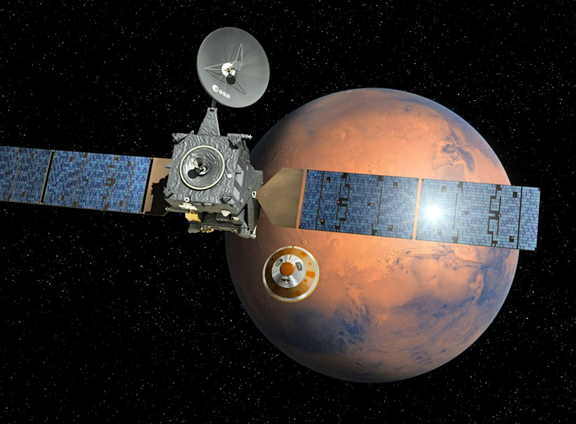
The ExoMars spacecraft built by Thales Alenia Space as prime contractor for the European Space Agency (ESA) has successfully completed the In-Orbit Commissioning Review (IOCR).
Thales Alenia Space has analyzed the results of the Launch and Early Orbit Phase (LEOP) and commissioning operations to draw up a report submitted to ESA. The report confirms the full functionality of the spacecraft’s two constituent modules: EDM (Entry and Descent Module) and TGO (Trace Gas Orbiter). Tests on the TGO during the LEOP phase confirmed that the satellite’s temperatures are within operational limits; the propulsion subsystem (Reaction Control System RCS) is operating as expected and energy consumption is nominal. The electrical parameters (voltage and current) remain stable in relation to the results of tests on Earth.

Artistic rendition that depicts the separation of the ExoMars 2016 entry, descent and landing demonstrator module, named Schiaparelli, from the Trace Gas Orbiter and heading for Mars.
TGO will be launched in 2016 with Schiaparelli, the entry, descent and landing demonstrator module and will search for evidence of methane and other atmospheric gases that could be signatures of active biological or geological processes on Mars. TGO will also serve as a communications relay for the rover and surface science platform that will be launched in 2018.
Image is courtesy of ESA — D. Ducros.
While ExoMars continues its journey towards Mars, Thales Alenia Space is completing its negotiations with ESA concerning activities for the follow-on of the interplanetary cruise, Mars approach and operational phases. Thales Alenia Space has recently signed a Record of Agreement with ESA for the second mission of this program, the Rover and Surface Platform Mission, expected to take place at the end of 2020.
The next milestones for ExoMars include...
- Mid-June – second TGO payload and EDM check-out
- Beginning of July – commissioning of the main TGO engine by performing a slight powered maneuver
- July 28 - DSM (Deep Space Maneuver), to place the spacecraft into the trajectory needed for it to land on Mars
- August 11 – trajectory adjustment
- September-October – simulation of the landing on Mars
- October 16 – EDM separates from the orbiter.October 19 –TGO enters into Martian orbit, while the EDM simultaneously lands on Mars

